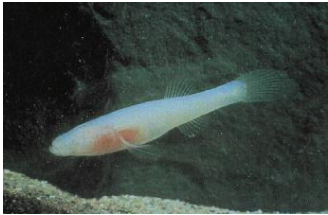Love is Blind
The Ozark cavefish is blind (USFWS, 2013). During the mating season, between the months February and April; when the cave floods in the spring time, the fish do not get to choose a mate (MDC, 2014 and USFWS, 2013). The possibility for fertilization to occur is the slim chance of a male and female cavefish sensing each other. These fish do not have eyes and everything is based solely on sensing; reproduction is one of the hardest thing to accomplish as an Ozark cavefish (USFWS, 2013). With this limitation, it is estimated that only 20 percent of the mature female Ozark cavefish spawn each year (MDC, 2014). This reproduction rate is one of the lowest population densities in the stygobiotic fish (Graening et al. 2010).

Although we know for a fact that these cavefish reproduce, there is no recorded evidence on how they laid their eggs nor where they put their fertilized eggs (Hardwerk, 2003). Even after hypothesis testing, there was no solid answer. Scientists therefore came up with one hypothesis that suggested that after fertilization, like the A. spelaea, a relative of the Ozark, the female is believed to carry her eggs in her gill chamber, incubating them, for about four to five months or until the eggs hatches (Handwerk, 2003, Noltie and Wicks, 2001, and Adams and Johnson, 2001). This action taken by the mother is seen as an extra level of protection to make sure the next generation is safe (Handwerk, 2003). This seems like an ideal and necessary protective step for the mother cavefish because it is believed that unlike other fish, cavefish females only produce 20 eggs each spawning season (MDC, 2014); without this extra effort, there is a higher possibility that the offspring will not live. This conclusion of how this organism reproduced was accepted after many observational studies, and scientists having found that cavefish don’t make nests (Hardwerk, 2003).
<<Interaction Homepage Endangered Species>>